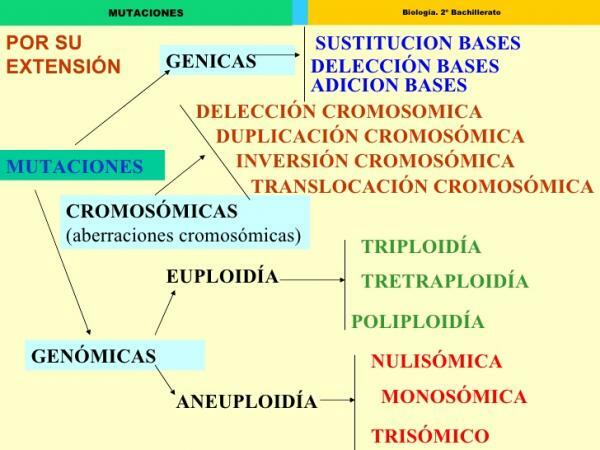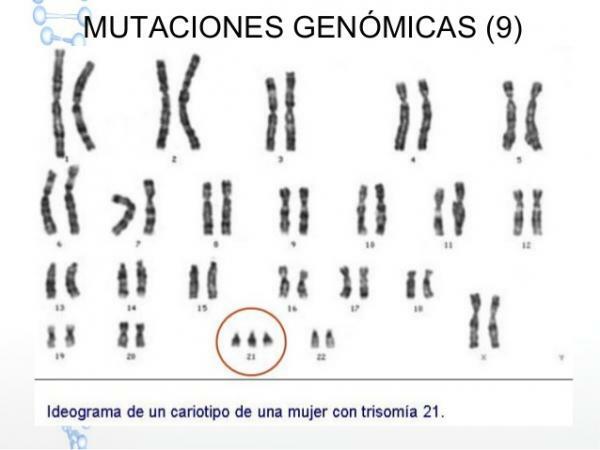All TYPES of gene mutation

Image: Metabolic Guide
Genetic mutations are any stable change that takes place in the genetic information of an individual, that is, in your DNA. But how important are genetic mutations? Are there different types of gene mutation? Are they all harmful or can some mutations be beneficial? Are all genetic mutations equally harmful? In this lesson from a TEACHER we will see what types of gene mutation they can exist and if they are more or less harmful.
Index
- Types of genetic mutations according to their effect
- Types of genetic mutations according to their level
- Types of gene or point mutations
- Chromosomal mutations
- Genomic mutations
Types of genetic mutations according to their effect.
The genetic mutations They are all that stable variation of the DNA of an individual. Mutations are mainly due to changes or errors that occur when the cell copies DNA to duplicate itself. These errors are not premeditated, that is, the cell does not think of producing this or that variation, they simply occur. Therefore, these changes can have three effects on the cell:
- Neutral or silent mutations: Some mutations may have no effect at all. It may be that the change does not affect the cell and the new cell, with the mutation, works and behaves the same as cells without mutation. Imagine that you are wearing red sneakers and you change them for blue ones, will it have any effect on how you walk?
- Harmful or harmful mutations: A mutation can have a negative effect. It may be that the change worsens the behavior or functionality of the cell, and the cell is impaired. Cells with the mutation work worse and may even die or get out of control, as in cancer. Imagine that instead of changing your shoes for others of another color, you take them off; in that case you would be worse off, right?
- Beneficial mutations: In other cases, a mutation can have beneficial effects. The change in a mutation may improve the behavior or function of the cell or of any of its parts, which makes it more resistant to a certain parasite or conditions environmental Imagine that now, you change those shoes for newer and more comfortable ones; this would be a nice change right?
In some cases, the mutations will not be neutral, good or bad by themselves, but will depend on the situation. If a certain condition occurs, a mutation can go from being neutral, and having no effect, to being very beneficial for an individual or even for an entire species. On the other hand, if conditions change, a mutation that makes us better adapted to one condition may lead to disadvantages in the new situation. What if we swap those slippers for some sandals? They will be beneficial when it is hot, but not when it is cold or when we are hiking in the mountains.

Image: Slideshare
Types of genetic mutations according to their level.
The classes of genetic mutations are not just about their effects. Another classification of genetic mutations has to do with the level of DNA they affect. Genetic mutations can affect:
- To small DNA sequences, that is, to one or a few letters with which DNA is written or encoded (nitrogenous bases). These mutations are the point, molecular or gene mutations. These mutations usually affect one gene.
- To large DNA sequences, which in turn modify the three-dimensional structure of DNA. These mutations affect large fragments of chromosomes, in which there is more than one gene, and are therefore called chromosomal mutations.
- To complete DNA chromosomes. The DNA of an individual is organized into chromosomes, like the different volumes of a very large and complex book. When mutations change the total number of chromosomes, they are said to be genomic mutations.
Within each level of genetic mutations, we can find different types of genetic mutations. In the following sections we will see the most common genetic mutations according to the level of DNA they affect.

Image: Slideshare
Types of gene or point mutations.
The point or gene mutations are those in which there is a change of a pair of bases or a few, affecting only one gene. DNA is encoded by 4 letters: A, T, G and C. The combination of these letters, three by three, form triplets. These triplets are read by an organelle of the cell, in charge of converting that code into proteins, some molecules have many varied functions in the body.
Point mutations can be due to:
- Insertion of bases. Occurs when an extra letter is put into the original sequence. Ex: from ATG we go to ATTG
- Deletion of bases. It occurs in the opposite case to the previous one, that is, when one or more letters of the triplet are eliminated. Ex: from ATG we go to AG
- Substitution of bases. It occurs when one of those letters is exchanged for another. This change can take effect or produce a silent mutation, which has no effect. Ex: from ATG we go to AAG
- Investment. One of the triplets that make up DNA is turned 180 degrees and, in the copy that is being made, the letters have the reverse order. Imagine that the original code tells us: ACG-TAG-CCA and, when copied, this sequence becomes ACG-GAT-CCA.
- Translocation. It occurs when a DNA triplet is copied in the wrong place, that is, where it does not belong. An example of a translocation would be a copy in which our starting sequence: ATT-GAT-CCT-AAT was converted when copied into ATT-CCT-AAT-GAT.
- Phase shift. Finally, when one or two nitrogenous bases are inserted or deleted, the DNA continues to form those triplets but, since a base has been removed or inserted, the following triplets also they change. You will see this better with this example: Imagine that we eliminate the second T from the original sequence ATT-GCA-ATG: the copy would remain ATG-CAA-TG; As you can see, the triplets that follow the one where we have produced the variation also change.

Image: Slideshare
Chromosomal mutations.
In this type of genetic mutations, the changes affect a larger base sequence fragment of a gene and, therefore, also produce changes in the three-dimensional structure of the chromosome. They are similar to the previous ones but affect more letters in the DNA sequence. Among the main chromosomal mutations are:
- Investment. A large chunk of sequence is flipped over when copied, and in the new sequence, the letters appear upside down.
- Duplication. In this case, a large chunk of the sequence is copied twice, usually in a row.
- Translocation. In this case, it may happen that a fragment of the sequence is simply copied to a place on the same chromosome that does not it belongs to you, it may appear in a different place on another chromosome, or it may be swapped with another chromosome. This exchange can be done with a homologous chromosome or with another chromosome that is not homologous.

Image: Monografias.com
Genomic mutations.
These types of genetic mutations, genomic mutations, changes affect the number of chromosomes. In this case, four situations can occur:
- Polyploidy: In this case of genomic mutation, more copies of all chromosomes are produced than due. For example, if a polyploidy were to occur in the case of humans (which does not occur as it leads to abortions natural), the individual would have instead of 46 chromosomes, for example, 69 (the normal 46 copies and one copy of each chromosome, 23 more).
- Haploidy: In this case, the individual has one less copy of each chromosome. In the case of humans, who have 2 copies of 23 chromosomes (46 in total), an individual with haploidy would have only 23 chromosomes, one copy of each.
- Polysomy: In this type of genomic mutation, the individual has more copies of a chromosome than they correspond to. A well-known case is that of individuals with Down syndrome, who have a trisomy of chromosome 21, that is, they have three copies instead of two.
- Monosomy. In this type of genomic mutation, on the contrary, the individual has fewer copies of a chromosome than they correspond to. In the case of humans, who only have two copies, there can only be monosomies. An example is Turner syndrome, which appears in women with a monosomy of the X chromosome, that is, they only have one copy of the X chromosome instead of two, as would be normal.
Genomic mutations tend to have great effects on the body, which is why, on many occasions, cause very serious illnesses or syndromes or even the death of the individual before it reaches born.

Image: Slideshare
If you want to read more articles similar to Types of genetic mutation, we recommend that you enter our category of biology.
Bibliography
- Metabolic Guide (July 23, 2013). Types of mutations.
- Benitobios (November 3, 2008). Types of mutations.



